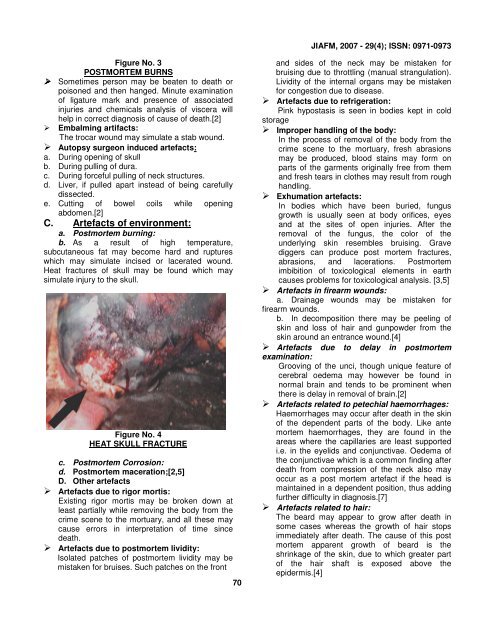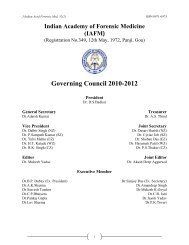Download - forensic medicine
Download - forensic medicine
Download - forensic medicine
Create successful ePaper yourself
Turn your PDF publications into a flip-book with our unique Google optimized e-Paper software.
JIAFM, 2007 - 29(4); ISSN: 0971-0973<br />
Figure No. 3<br />
POSTMORTEM BURNS<br />
Sometimes person may be beaten to death or<br />
poisoned and then hanged. Minute examination<br />
of ligature mark and presence of associated<br />
injuries and chemicals analysis of viscera will<br />
help in correct diagnosis of cause of death.[2]<br />
Embalming artifacts:<br />
The trocar wound may simulate a stab wound.<br />
Autopsy surgeon induced artefacts:<br />
a. During opening of skull<br />
b. During pulling of dura.<br />
c. During forceful pulling of neck structures.<br />
d. Liver, if pulled apart instead of being carefully<br />
dissected.<br />
e. Cutting of bowel coils while opening<br />
abdomen.[2]<br />
C. Artefacts of environment:<br />
a. Postmortem burning:<br />
b. As a result of high temperature,<br />
subcutaneous fat may become hard and ruptures<br />
which may simulate incised or lacerated wound.<br />
Heat fractures of skull may be found which may<br />
simulate injury to the skull.<br />
Figure No. 4<br />
HEAT SKULL FRACTURE<br />
c. Postmortem Corrosion:<br />
d. Postmortem maceration;[2,5]<br />
D. Other artefacts<br />
Artefacts due to rigor mortis:<br />
Existing rigor mortis may be broken down at<br />
least partially while removing the body from the<br />
crime scene to the mortuary, and all these may<br />
cause errors in interpretation of time since<br />
death.<br />
Artefacts due to postmortem lividity:<br />
Isolated patches of postmortem lividity may be<br />
mistaken for bruises. Such patches on the front<br />
70<br />
and sides of the neck may be mistaken for<br />
bruising due to throttling (manual strangulation).<br />
Lividity of the internal organs may be mistaken<br />
for congestion due to disease.<br />
Artefacts due to refrigeration:<br />
Pink hypostasis is seen in bodies kept in cold<br />
storage<br />
Improper handling of the body:<br />
In the process of removal of the body from the<br />
crime scene to the mortuary, fresh abrasions<br />
may be produced, blood stains may form on<br />
parts of the garments originally free from them<br />
and fresh tears in clothes may result from rough<br />
handling.<br />
Exhumation artefacts:<br />
In bodies which have been buried, fungus<br />
growth is usually seen at body orifices, eyes<br />
and at the sites of open injuries. After the<br />
removal of the fungus, the color of the<br />
underlying skin resembles bruising. Grave<br />
diggers can produce post mortem fractures,<br />
abrasions, and lacerations. Postmortem<br />
imbibition of toxicological elements in earth<br />
causes problems for toxicological analysis. [3,5]<br />
Artefacts in firearm wounds:<br />
a. Drainage wounds may be mistaken for<br />
firearm wounds.<br />
b. In decomposition there may be peeling of<br />
skin and loss of hair and gunpowder from the<br />
skin around an entrance wound.[4]<br />
Artefacts due to delay in postmortem<br />
examination:<br />
Grooving of the unci, though unique feature of<br />
cerebral oedema may however be found in<br />
normal brain and tends to be prominent when<br />
there is delay in removal of brain.[2]<br />
Artefacts related to petechial haemorrhages:<br />
Haemorrhages may occur after death in the skin<br />
of the dependent parts of the body. Like ante<br />
mortem haemorrhages, they are found in the<br />
areas where the capillaries are least supported<br />
i.e. in the eyelids and conjunctivae. Oedema of<br />
the conjunctivae which is a common finding after<br />
death from compression of the neck also may<br />
occur as a post mortem artefact if the head is<br />
maintained in a dependent position, thus adding<br />
further difficulty in diagnosis.[7]<br />
Artefacts related to hair:<br />
The beard may appear to grow after death in<br />
some cases whereas the growth of hair stops<br />
immediately after death. The cause of this post<br />
mortem apparent growth of beard is the<br />
shrinkage of the skin, due to which greater part<br />
of the hair shaft is exposed above the<br />
epidermis.[4]




![syllabus in forensic medicine for m.b.b.s. students in india [pdf]](https://img.yumpu.com/48405011/1/190x245/syllabus-in-forensic-medicine-for-mbbs-students-in-india-pdf.jpg?quality=85)



![SPOTTING IN FORENSIC MEDICINE [pdf]](https://img.yumpu.com/45856557/1/190x245/spotting-in-forensic-medicine-pdf.jpg?quality=85)

![JAFM-33-2, April-June, 2011 [PDF] - forensic medicine](https://img.yumpu.com/43461356/1/190x245/jafm-33-2-april-june-2011-pdf-forensic-medicine.jpg?quality=85)



![JIAFM-33-4, October-December, 2011 [PDF] - forensic medicine](https://img.yumpu.com/31013278/1/190x245/jiafm-33-4-october-december-2011-pdf-forensic-medicine.jpg?quality=85)

